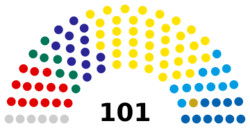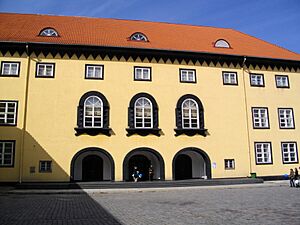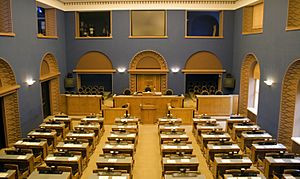Riigikogu facts for kids
Quick facts for kids Parliament of EstoniaRiigikogu |
|
|---|---|
| XV Riigikogu | |
 |
|
| Type | |
| Type | |
| History | |
| Founded | 23 April 1919 21 October 1992 (re-established) |
| Disbanded | 1940–1991 |
| Leadership | |
|
Chairman
|
Lauri Hussar, Estonia 200
Since 10 April 2023 |
|
First Vice-Chairman
|
Toomas Kivimägi, Reform
Since 10 April 2023 |
|
Second Vice-Chairman
|
Arvo Aller, EKRE
Since 15 July 2024 |
| Structure | |
| Seats | 101 |
 |
|
|
Political groups
|
Government (52)
Opposition (49)
|
| Committees |
11 Committees
Constitutional
Cultural Affairs Economic Affairs Environment European Union Affairs Finance Foreign Affairs Legal Affairs National Defence Rural Affairs Social Affairs |
| Elections | |
| Party-list proportional representation Modified D'Hondt method |
|
|
Last election
|
5 March 2023 |
|
Next election
|
By 7 March 2027 |
| Meeting place | |
 |
|
| Parliament building in Toompea Castle, Tallinn | |
| Website | |
| www.riigikogu.ee | |
The Riigikogu (pronounced REE-gee-koh-goo) is the main law-making body of Estonia. Its name comes from Estonian words meaning "state" and "assembly." Think of it as Estonia's national team of lawmakers!
The Riigikogu has 101 members. These members are chosen by the people of Estonia in elections. They work together to make important decisions for the country.
Their main jobs include:
- Making new laws and changing old ones.
- Choosing important leaders like the Prime Minister and the head judge of the Supreme Court.
- Sometimes, they also help choose the President.
- Approving the country's budget, which is like a spending plan for the government.
- Making sure the government is doing its job well.
- Approving important agreements with other countries.
Contents
The Story of Estonia's Parliament
How the Riigikogu Began
The Riigikogu started its journey on April 23, 1919. This was when the first Estonian Constituent Assembly met. It was a big step for Estonia to become an independent country.
The first rules for the Riigikogu were set in the 1920 constitution. Back then, it had 100 members. They were elected for three years. These elections used a system called proportional representation. This means that parties got seats based on the percentage of votes they received.
The Riigikogu has always met in the Toompea Castle in Tallinn. A special building was built there between 1920 and 1922. It has a unique style called Expressionist.
Changes and Challenges
Over time, Estonia's government structure changed. In 1933, new rules gave more power to the President. A few years later, in 1937, a second constitution was approved. This created a parliament with two parts, like some other countries have.
However, Estonia faced difficult times. Between 1940 and 1991, the country was occupied by other powers. During these years, the Riigikogu could not operate. It was a period when Estonia lost its independence.
Estonia Becomes Independent Again
Estonia regained its independence in 1991. A year later, in September 1992, new elections were held. This was a very exciting time for the country!
A new constitution was also created in 1992. It brought back a parliament with one main chamber, just like the early Riigikogu. This new parliament has 101 members.
The way members are elected is mostly by proportional representation. However, there's a rule: a political party needs to get at least 5% of the votes to win seats. This helps ensure that only parties with significant support get into parliament.
Who is in the Riigikogu Now?
The most recent elections for the Riigikogu were held on March 5, 2023. After these elections, the 101 seats in parliament were divided among different political parties.
Here's how the seats are currently shared:
- Reform Party: 38 members
- Social Democratic Party of Estonia: 14 members
- Estonia 200: 13 members
- Conservative People's Party of Estonia: 11 members
- Isamaa: 11 members
- Centre Party: 6 members
- Independent members (not part of a party): 8 members
These parties work together (or sometimes disagree!) to represent the people of Estonia.
Leaders of the Riigikogu
The person who leads the Riigikogu meetings is called the Speaker. They are like the referee in a game, making sure everyone follows the rules and gets a chance to speak. The Speaker helps guide the discussions and votes on new laws.
Here are the Speakers of the Riigikogu since Estonia regained its independence in 1992:
| Name | Period | Legislature |
|---|---|---|
| Ülo Nugis | October 21, 1992 – March 21, 1995 | VII Riigikogu |
| Toomas Savi | March 21, 1995 – March 31, 2003 | VIII Riigikogu, IX Riigikogu |
| Ene Ergma | March 31, 2003 – March 23, 2006 | X Riigikogu |
| Toomas Varek | March 23, 2006 – April 2, 2007 | X Riigikogu |
| Ene Ergma | April 2, 2007 – March 20, 2014 | XI Riigikogu, XII Riigikogu |
| Eiki Nestor | March 20, 2014 – April 4, 2019 | XII Riigikogu, XIII Riigikogu |
| Henn Põlluaas | April 4, 2019 – March 18, 2021 | XIV Riigikogu |
| Jüri Ratas | March 18, 2021 – April 10, 2023 | XIV Riigikogu |
| Lauri Hussar | April 10, 2023 – present | XV Riigikogu |
The Riigikogu's Helpers
The Riigikogu has a special team called the Chancellery of the Riigikogu. This team was created on October 5, 1992. Their job is to help the members of parliament do their work every day. They handle all the important tasks that keep the Riigikogu running smoothly.
See also
 In Spanish: Riigikogu para niños
In Spanish: Riigikogu para niños


